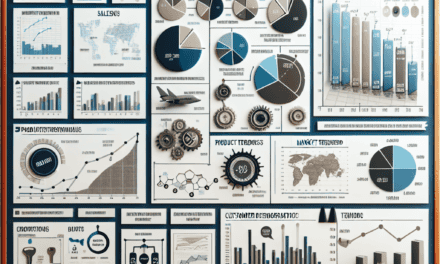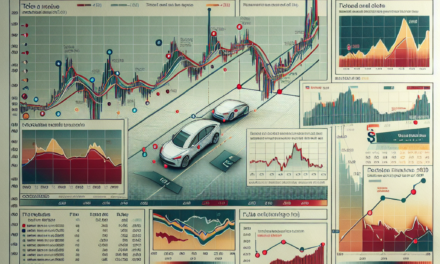“Anticipation Fuels Gains: Markets Climb as Fed Decision Looms”
Introduction
Markets experienced a notable uptick as investors eagerly anticipated the Federal Reserve’s upcoming decision on interest rates. This surge in stock prices reflects a cautious optimism among market participants, who are closely monitoring economic indicators and central bank signals for insights into future monetary policy. The rally underscores the delicate balance between inflation concerns and growth prospects, as traders weigh the potential impacts of the Fed’s actions on various sectors. As the financial community braces for the Fed’s announcement, the current market dynamics highlight the intricate interplay between policy expectations and investor sentiment.
Impact Of Federal Reserve Decisions On Stock Markets
The anticipation surrounding Federal Reserve decisions often casts a significant shadow over the stock markets, influencing investor sentiment and market dynamics. As markets rise ahead of the latest Fed decision, it is crucial to understand the intricate relationship between Federal Reserve policies and stock market performance. The Federal Reserve, as the central bank of the United States, plays a pivotal role in shaping economic policy through its control over interest rates and monetary policy. Consequently, its decisions can have profound implications for financial markets, affecting everything from stock prices to investor confidence.
To begin with, the Federal Reserve’s primary tool for influencing the economy is the adjustment of interest rates. When the Fed decides to lower interest rates, it effectively reduces the cost of borrowing, encouraging businesses to invest and consumers to spend. This increased economic activity can lead to higher corporate earnings, which in turn boosts stock prices. Conversely, when the Fed raises interest rates, borrowing becomes more expensive, potentially slowing down economic growth and putting downward pressure on stock prices. Therefore, the anticipation of a Fed decision often leads to heightened market volatility as investors attempt to predict the central bank’s next move.
Moreover, the Federal Reserve’s communication strategy, including its forward guidance, plays a crucial role in shaping market expectations. By signaling its future policy intentions, the Fed can influence investor behavior even before any actual policy changes occur. For instance, if the Fed indicates a dovish stance, suggesting that it is likely to keep interest rates low for an extended period, investors may become more optimistic about future economic growth and corporate profitability. This optimism can drive stock prices higher as investors adjust their portfolios in anticipation of favorable conditions.
In addition to interest rate decisions, the Federal Reserve’s quantitative easing (QE) programs have also had a significant impact on stock markets. Through QE, the Fed purchases large quantities of government securities and other financial assets, injecting liquidity into the financial system. This increased liquidity can lead to lower yields on bonds, prompting investors to seek higher returns in the stock market. As a result, stock prices may rise as investors allocate more capital to equities in search of better returns.
Furthermore, the global nature of financial markets means that Federal Reserve decisions can have ripple effects beyond the United States. As the world’s largest economy, U.S. monetary policy can influence global capital flows and exchange rates. For example, a decision by the Fed to raise interest rates could lead to a stronger U.S. dollar, making American exports more expensive and potentially impacting the earnings of multinational corporations. This interconnectedness underscores the importance of Fed decisions not only for domestic markets but also for international investors.
In conclusion, the impact of Federal Reserve decisions on stock markets is multifaceted, encompassing interest rate adjustments, forward guidance, and quantitative easing measures. As markets rise ahead of the latest Fed decision, investors remain keenly aware of the central bank’s influence on economic conditions and market sentiment. By understanding the mechanisms through which the Fed affects financial markets, investors can better navigate the complexities of market dynamics and make informed decisions in an ever-evolving economic landscape.
Key Indicators Driving Market Optimism
As markets anticipate the Federal Reserve’s upcoming decision on interest rates, a wave of optimism has swept through the financial landscape, driving stocks higher. This buoyancy in the markets is underpinned by several key indicators that suggest a favorable economic environment, fostering investor confidence. To begin with, recent economic data has painted a picture of resilience, with consumer spending showing unexpected strength. Retail sales figures have surpassed expectations, indicating that consumers remain willing to spend despite inflationary pressures. This robust consumer activity is a critical component of economic growth, as it accounts for a significant portion of the GDP. Consequently, the positive retail data has alleviated some concerns about a potential economic slowdown, encouraging investors to remain engaged in the equity markets.
In addition to consumer spending, the labor market continues to exhibit signs of vitality. Unemployment rates have remained low, and job creation has been steady, further reinforcing the notion that the economy is on solid footing. The strength of the labor market not only supports consumer spending but also contributes to overall economic stability. As more individuals find employment, disposable income levels rise, which in turn fuels further economic activity. This virtuous cycle has been a key driver of market optimism, as investors interpret these indicators as signals of sustained economic momentum.
Moreover, corporate earnings have played a pivotal role in bolstering market sentiment. Many companies have reported better-than-expected earnings, demonstrating their ability to navigate the challenging economic landscape. This resilience in corporate performance has reassured investors, who are now more confident in the long-term prospects of these firms. As a result, stock prices have been buoyed by strong earnings reports, further contributing to the upward trajectory of the markets.
Another factor contributing to the current market optimism is the anticipation of the Federal Reserve’s policy decision. While there is some uncertainty regarding the Fed’s next move, many investors are hopeful that the central bank will adopt a more measured approach to interest rate adjustments. The possibility of a pause or a slower pace of rate hikes has been welcomed by the markets, as it would alleviate some of the pressure on borrowing costs and support continued economic expansion. This expectation has been a significant driver of recent market gains, as investors position themselves for a potentially favorable outcome.
Furthermore, geopolitical developments have also played a role in shaping market sentiment. Recent diplomatic efforts have eased tensions in certain regions, reducing the risk of potential disruptions to global trade. This de-escalation has been viewed positively by investors, who are now more optimistic about the prospects for international economic cooperation and growth. The stabilization of geopolitical conditions has provided an additional layer of confidence, encouraging market participants to maintain their exposure to equities.
In conclusion, the confluence of strong consumer spending, a robust labor market, resilient corporate earnings, and favorable geopolitical developments has created an environment of optimism in the financial markets. As investors await the Federal Reserve’s decision, these key indicators have provided a solid foundation for the recent rise in stock prices. While uncertainties remain, the current landscape suggests that the markets are well-positioned to navigate the challenges ahead, buoyed by a combination of economic strength and cautious optimism.
Historical Analysis Of Market Reactions To Fed Announcements
As investors keenly anticipate the Federal Reserve’s upcoming decision on interest rates, it is instructive to examine historical market reactions to similar announcements. Understanding these patterns can provide valuable insights into potential market movements and investor sentiment. Historically, Federal Reserve decisions have wielded significant influence over financial markets, often triggering immediate and sometimes volatile responses. This influence stems from the Fed’s role in setting monetary policy, which directly impacts borrowing costs, consumer spending, and overall economic growth.
Looking back, one can observe that markets tend to react in a variety of ways depending on the nature of the Fed’s announcement. For instance, when the Fed signals a rate hike, markets often experience a short-term decline. This reaction is primarily due to the increased cost of borrowing, which can dampen corporate profits and consumer spending. However, it is crucial to note that the long-term effects of such announcements can vary. In some cases, a rate hike may be perceived as a sign of a strengthening economy, which can eventually lead to a market rebound as investor confidence grows.
Conversely, when the Fed announces a rate cut, markets typically respond positively in the short term. Lower interest rates reduce borrowing costs, encouraging both consumer spending and business investment. This immediate boost in economic activity often leads to a rise in stock prices. Nevertheless, the long-term implications of rate cuts can be complex. While they may stimulate growth initially, prolonged periods of low interest rates can lead to concerns about inflation and asset bubbles, which can eventually weigh on market performance.
Moreover, the context in which these announcements occur plays a critical role in shaping market reactions. For example, during periods of economic uncertainty or recession, a rate cut might be viewed as a necessary measure to support the economy, leading to a more sustained positive market response. In contrast, during times of economic expansion, the same rate cut might raise concerns about potential overheating and inflation, resulting in a more muted or even negative market reaction.
In addition to the immediate impact of interest rate decisions, the Fed’s accompanying statements and forward guidance are also pivotal in shaping market expectations. Investors closely scrutinize the language used by the Fed to glean insights into future policy directions. A hawkish tone, indicating a likelihood of future rate hikes, can temper market enthusiasm even in the face of a current rate cut. Conversely, a dovish tone, suggesting a more accommodative stance, can bolster market confidence.
Furthermore, it is essential to consider the broader economic environment and geopolitical factors that may influence market reactions to Fed announcements. For instance, during times of global economic instability or geopolitical tensions, markets may react more sensitively to Fed decisions as investors seek stability and predictability.
In conclusion, while historical analysis provides valuable insights into market reactions to Federal Reserve announcements, it is important to recognize the complexity and variability of these responses. Each decision is made within a unique economic context, and investor sentiment can be influenced by a multitude of factors beyond the Fed’s control. As such, while past patterns can offer guidance, they should be considered alongside current economic conditions and broader market dynamics to form a comprehensive understanding of potential market movements.
Sector Performance: Winners And Losers In A Rising Market
As markets continue to rise ahead of the Federal Reserve’s impending decision on interest rates, investors are keenly observing sector performance to identify the winners and losers in this dynamic environment. The anticipation surrounding the Fed’s decision has injected a sense of optimism into the market, with many sectors experiencing notable gains. However, not all sectors are benefiting equally, and the disparities in performance highlight the complexities of the current economic landscape.
To begin with, the technology sector has emerged as a clear winner in this rising market. Driven by robust earnings reports and continued innovation, tech companies have seen their stock prices soar. The demand for digital solutions and advancements in artificial intelligence have further bolstered investor confidence in this sector. As a result, major tech firms have experienced significant capital inflows, pushing their valuations to new heights. This trend underscores the sector’s resilience and its pivotal role in shaping the future economy.
In contrast, the energy sector has faced challenges despite the overall market uptrend. Fluctuating oil prices and concerns over sustainability have created a volatile environment for energy stocks. While some companies have managed to adapt by investing in renewable energy sources, others have struggled to maintain profitability. Consequently, the energy sector’s performance has been mixed, with some firms experiencing gains while others lag behind. This divergence within the sector reflects broader shifts in energy consumption patterns and the growing emphasis on environmental responsibility.
Meanwhile, the healthcare sector has also shown promising performance, buoyed by advancements in biotechnology and pharmaceuticals. The ongoing development of innovative treatments and therapies has attracted significant investor interest, leading to increased stock valuations. Additionally, the aging global population and heightened focus on healthcare accessibility have further strengthened the sector’s outlook. As a result, healthcare stocks have become a favored choice for investors seeking stability and growth potential in an uncertain market.
On the other hand, the financial sector has experienced a more subdued performance. While rising interest rates typically benefit banks by increasing their net interest margins, concerns over economic slowdown and regulatory changes have tempered investor enthusiasm. Moreover, the potential for increased loan defaults in a high-interest-rate environment has added an element of caution. Despite these challenges, some financial institutions have managed to capitalize on the market’s upward momentum by diversifying their revenue streams and enhancing digital offerings.
In addition to these sectors, consumer discretionary stocks have also captured attention as consumer spending patterns evolve. With the easing of pandemic-related restrictions, there has been a resurgence in demand for travel, entertainment, and luxury goods. Companies in these industries have reported strong earnings, reflecting pent-up consumer demand and a willingness to spend on experiences. However, inflationary pressures and supply chain disruptions remain potential headwinds that could impact future performance.
In summary, the rising market ahead of the Federal Reserve’s decision has created a varied landscape of sector performance, with technology and healthcare emerging as clear winners, while energy and financial sectors face more nuanced challenges. As investors navigate this complex environment, understanding the underlying factors driving each sector’s performance will be crucial in making informed investment decisions. The interplay between economic indicators, consumer behavior, and regulatory developments will continue to shape the market’s trajectory, offering both opportunities and risks for discerning investors.
Investor Sentiment And Its Influence On Market Trends
Investor sentiment plays a crucial role in shaping market trends, often acting as a barometer for future economic conditions. As markets rise ahead of the Federal Reserve’s impending decision, understanding the nuances of investor sentiment becomes increasingly important. This sentiment, a complex amalgamation of optimism, fear, and speculation, can significantly influence stock market movements, creating ripples that extend beyond immediate financial landscapes.
In recent weeks, investor sentiment has been buoyed by a series of positive economic indicators, including robust employment figures and steady consumer spending. These factors have contributed to a sense of optimism, encouraging investors to adopt a more risk-on approach. Consequently, stock markets have experienced an upward trajectory, with major indices reflecting this renewed confidence. The anticipation surrounding the Federal Reserve’s decision on interest rates further amplifies this sentiment, as investors speculate on the potential implications for economic growth and inflation.
Moreover, the interplay between investor sentiment and market trends is not merely a one-way street. While sentiment can drive market movements, these movements, in turn, can reinforce or alter prevailing sentiments. For instance, as stock prices rise, the wealth effect may come into play, where increased asset values boost consumer confidence and spending, thereby fostering a positive feedback loop. This dynamic underscores the intricate relationship between psychological factors and tangible economic outcomes.
However, it is essential to recognize that investor sentiment is not solely driven by domestic factors. Global economic conditions, geopolitical developments, and international trade dynamics also play pivotal roles in shaping market perceptions. In the current context, the global economic landscape presents a mixed picture. While some regions exhibit signs of recovery, others grapple with persistent challenges, such as supply chain disruptions and inflationary pressures. These global factors add layers of complexity to investor sentiment, influencing market trends in multifaceted ways.
As the Federal Reserve’s decision looms, market participants are keenly attuned to any signals that may indicate the central bank’s future policy direction. The Fed’s stance on interest rates is particularly significant, as it directly impacts borrowing costs, consumer spending, and corporate investment. A decision to maintain or adjust interest rates can send ripples through financial markets, affecting everything from bond yields to stock valuations. Consequently, investors are closely monitoring the Fed’s communications for any hints of policy shifts, which could either bolster or dampen current market optimism.
In this environment, the role of investor sentiment becomes even more pronounced. Market participants must navigate a landscape characterized by both opportunities and uncertainties, making sentiment a critical factor in decision-making processes. While positive sentiment can drive markets higher, it is also susceptible to rapid shifts, particularly in response to unexpected developments or changes in economic indicators. Therefore, maintaining a balanced perspective is crucial for investors seeking to capitalize on market trends while mitigating potential risks.
In conclusion, investor sentiment is a powerful force that influences market trends, particularly in the lead-up to significant events such as the Federal Reserve’s decision. As markets rise, driven by a confluence of domestic and global factors, understanding the intricacies of sentiment becomes essential for investors aiming to navigate the complexities of the financial landscape. By recognizing the interplay between sentiment and market movements, investors can better position themselves to respond to evolving economic conditions and make informed decisions in an ever-changing environment.
Global Market Reactions To U.S. Federal Reserve Policies
As global markets continue to navigate the complexities of economic recovery, the anticipation surrounding the U.S. Federal Reserve’s policy decisions remains a focal point for investors worldwide. Recently, markets have shown a notable uptick, reflecting a cautious optimism ahead of the Federal Reserve’s upcoming decision on interest rates. This development underscores the profound influence that U.S. monetary policy exerts on global financial markets, as investors keenly await signals that could shape economic trajectories across continents.
In the lead-up to the Federal Reserve’s announcement, stock markets have experienced a rally, driven by speculation and strategic positioning by investors. This rise is not merely a reflection of domestic economic indicators but also a response to the interconnected nature of global markets. As the U.S. economy plays a pivotal role in the global financial ecosystem, any policy shifts by the Federal Reserve are closely monitored by international investors who seek to mitigate risks and capitalize on potential opportunities.
The anticipation of the Federal Reserve’s decision has led to increased volatility in stock markets, with investors weighing the potential implications of interest rate adjustments. A decision to maintain current rates could signal confidence in the ongoing economic recovery, potentially bolstering investor sentiment and encouraging further market gains. Conversely, an unexpected rate hike might be perceived as a preemptive measure to curb inflationary pressures, which could lead to a more cautious approach by investors, potentially tempering market enthusiasm.
Moreover, the ripple effects of the Federal Reserve’s policies extend beyond the U.S. borders, influencing global economic conditions. Emerging markets, in particular, are sensitive to changes in U.S. interest rates, as they often rely on foreign capital inflows to sustain growth. A rise in U.S. rates could lead to capital outflows from these markets, as investors seek higher returns in a more stable economic environment. This dynamic highlights the delicate balance that the Federal Reserve must maintain to support domestic economic objectives while considering the broader global impact.
In addition to emerging markets, developed economies are also attuned to the Federal Reserve’s policy direction. European and Asian markets, for instance, often react to U.S. monetary policy shifts, as these decisions can influence currency valuations, trade balances, and cross-border investment flows. The interconnectedness of these economies means that a change in U.S. interest rates can have far-reaching consequences, affecting everything from corporate earnings to consumer spending patterns.
As investors await the Federal Reserve’s decision, market analysts are closely examining economic indicators such as employment data, inflation rates, and consumer confidence levels. These metrics provide valuable insights into the health of the U.S. economy and help shape expectations regarding future monetary policy actions. By analyzing these indicators, investors can better position themselves to navigate the potential market fluctuations that may arise following the Federal Reserve’s announcement.
In conclusion, the recent rise in global markets ahead of the Federal Reserve’s decision underscores the significant influence of U.S. monetary policy on international financial landscapes. As investors brace for potential changes in interest rates, the interconnected nature of global markets becomes increasingly apparent. By understanding the implications of the Federal Reserve’s policies, investors can make informed decisions that align with their strategic objectives, ultimately contributing to a more resilient and dynamic global economy.
Strategies For Investors During Fed Decision Periods
As markets anticipate the Federal Reserve’s upcoming decision on interest rates, investors are keenly observing the potential implications for their portfolios. The period leading up to a Fed decision is often characterized by heightened volatility and uncertainty, making it crucial for investors to adopt strategic approaches to navigate these turbulent waters. Understanding the dynamics at play can help investors make informed decisions that align with their financial goals.
Firstly, it is essential for investors to stay informed about the economic indicators that the Federal Reserve considers when making its decisions. Key metrics such as inflation rates, employment figures, and GDP growth are pivotal in shaping the Fed’s policy direction. By keeping abreast of these indicators, investors can better anticipate potential rate changes and adjust their strategies accordingly. For instance, if inflation is trending higher than expected, the Fed might lean towards tightening monetary policy, which could impact interest-sensitive sectors like real estate and utilities.
Moreover, diversification remains a cornerstone strategy during periods of uncertainty. By spreading investments across various asset classes, sectors, and geographies, investors can mitigate risks associated with any single economic event or policy decision. Diversification not only helps in cushioning the impact of adverse market movements but also provides opportunities to capitalize on sectors that may benefit from the Fed’s actions. For example, if the Fed signals a dovish stance, growth stocks, particularly in the technology sector, might experience a boost due to lower borrowing costs.
In addition to diversification, maintaining a long-term perspective is crucial. While short-term market fluctuations can be unsettling, it is important to remember that investing is inherently a long-term endeavor. Historical data suggests that markets tend to recover from short-term volatility, and those who remain invested often reap the benefits over time. Therefore, rather than reacting impulsively to market movements, investors should focus on their long-term financial objectives and remain disciplined in their investment approach.
Furthermore, investors should consider the role of fixed-income securities in their portfolios during Fed decision periods. Bonds and other fixed-income instruments can provide stability and income, especially when equity markets are volatile. However, it is important to be mindful of the interest rate environment, as rising rates can negatively impact bond prices. In such scenarios, investors might explore shorter-duration bonds or inflation-protected securities to hedge against potential rate hikes.
Additionally, maintaining liquidity is a prudent strategy during uncertain times. Having a portion of the portfolio in cash or cash-equivalents allows investors to take advantage of market opportunities as they arise. This liquidity can be particularly beneficial if the Fed’s decision leads to significant market corrections, enabling investors to buy quality assets at discounted prices.
Finally, consulting with financial advisors can provide valuable insights and guidance tailored to individual circumstances. Advisors can help investors assess their risk tolerance, review their asset allocation, and make adjustments that align with their financial goals and market conditions. By leveraging professional expertise, investors can navigate the complexities of Fed decision periods with greater confidence.
In conclusion, while the period leading up to a Federal Reserve decision can be fraught with uncertainty, adopting strategic approaches can help investors manage risks and seize opportunities. By staying informed, diversifying, maintaining a long-term perspective, considering fixed-income options, ensuring liquidity, and seeking professional advice, investors can position themselves to weather the volatility and achieve their financial objectives.
Q&A
1. **What is the main focus of the market update?**
The main focus is on the rise in markets ahead of the Federal Reserve’s decision on interest rates.
2. **Which major stock indices are mentioned?**
Commonly mentioned indices include the S&P 500, Dow Jones Industrial Average, and Nasdaq Composite.
3. **What is the anticipated action by the Federal Reserve?**
The Federal Reserve is expected to announce its decision on interest rates, which could involve maintaining, increasing, or decreasing rates.
4. **How are investors reacting to the upcoming Fed decision?**
Investors are generally optimistic, leading to a rise in stock prices as they anticipate favorable outcomes from the Fed’s decision.
5. **What sectors are showing significant movement?**
Technology, financials, and consumer discretionary sectors often show significant movement in response to Fed decisions.
6. **Are there any notable company performances highlighted?**
Specific companies, particularly those sensitive to interest rate changes, may be highlighted for their stock performance.
7. **What are analysts predicting for the market’s future?**
Analysts may predict continued volatility or stability depending on the Fed’s decision and its implications for economic growth and inflation.
Conclusion
The anticipation of the Federal Reserve’s decision has led to a positive movement in the stock markets, as investors are optimistic about potential outcomes that could favor economic growth. This rise in market indices reflects investor confidence and a hopeful outlook on monetary policy adjustments that may support continued economic expansion. However, the actual impact will depend on the Fed’s announcements and subsequent market reactions, which could either sustain the upward trend or introduce volatility depending on the specifics of the decision.





